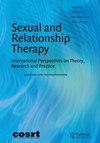情爱关系中色情消费与性欲的关系
IF 1.4
4区 心理学
Q3 PSYCHOLOGY, CLINICAL
引用次数: 0
摘要
在社会中,色情消费通常与人际关系中的负面结果联系在一起。一些研究也引起了人们对色情消费可能产生的积极结果的关注。目前的研究调查了1742名处于恋爱关系中的个人的网络色情使用背景和性欲之间的关系。通过使用在线问卷,我们比较了共享色情消费、和谐的单独消费、不和谐的消费和不消费。这项研究的重点是两性关系中的性交频率和以伴侣为中心的二元性欲。结果表明,与不一致的消费者和单独一致的消费者相比,共享色情消费者和非消费者每月的性交频率最高。在性欲方面,共享消费者和不和谐消费者的性欲最高。然而,这种影响更多的是由性别的影响而不是色情消费的背景造成的,因为男性比女性表现出更高的性欲。本研究中获得的结果的含义、意义和局限性也讨论了与所包括的调节变量有关的问题。建议在未来的研究中对这些因素的关联进行调查。根据这些发现,讨论了进一步研究的几个方向。这项研究调查了色情作品与两性关系中的性欲之间的联系。我们比较了在一起看色情片、单独看色情片、只有一方看色情片或根本不看色情片的关系中的个体。共有色情消费者和不一致色情消费者的性欲最高。关键词:色情浪漫关系性活动性欲披露声明作者未获得任何组织对所提交作品的支持。作者没有与本文内容相关的竞争利益要声明。伦理批准:已获得查尔斯大学文学院伦理委员会的批准。本研究使用的程序遵循《赫尔辛基宣言》的原则。所有人类参与者在填写问卷前阅读并批准了知情同意书。数据可用性声明同行评审的公开数据集可以在这里找到:开放科学框架。https://osf.io/ru2wk/?view_only=dc09a034b437452d92d3ba332d283d84Additional信息contributorsEliška Burian LexováEliška Burian lexov本文章由计算机程序翻译,如有差异,请以英文原文为准。
Context of pornography consumption and sexual desire in romantic relationships
AbstractIn society, pornography consumption is generally associated mostly with negative outcomes in relationships. Several studies also draw attention to the positive outcomes that pornography consumption can have. The current study investigated associations between the context of internet pornography use and sexual desire in a sample of 1742 individuals in romantic relationships. Having used an online questionnaire, we compared shared pornography consumption, concordant solitary consumption, discordant consumption, and no consumption. The study centred on the frequency of intercourse in relationships and partner-focused dyadic sexual desire. Results showed that shared pornography consumers and non-consumers had the highest frequency of intercourse per month compared to discordant consumers and solitary concordant consumers. In terms of sexual desire, shared consumers and discordant consumers had the highest sexual desire. However, the effect is caused more by the influence of gender than by the context of pornography consumption, as males showed higher sexual desire than females. Implications, significance, and limitations of obtained results in the present study are also discussed in relation to moderating variables included. It is suggested that the associations of these factors are investigated in future studies. Several directions for further research are discussed in light of these findings.LAY SUMMARYThe research examines the connections between pornography and sexual desire in relationships. We compare individuals from relationships in which pornography is consumed together, separately, by only one of the partners, or not at all. Shared pornography consumers and discordant consumers had the highest sexual desire.Keywords: Pornographyromantic relationshipssexual activitysexual desire Disclosure statementThe authors did not receive support from any organization for the submitted work. The authors have no competing interests to declare that are relevant to the content of this article.Ethics approvalApproval was obtained from the ethics committee of the Faculty of Arts, Charles University. The procedures used in this study adhere to the tenets of the Declaration of Helsinki. All human participants read and approved the informed consent before completing the questionnaire.Data availability statementThe publicly available dataset for peer review can be found here: Open Science Framework. https://osf.io/ru2wk/?view_only=dc09a034b437452d92d3ba332d283d84Additional informationNotes on contributorsEliška Burian LexováEliška Burian Lexová: PhD student at the Department of Psychology, Faculty of Arts, Charles University, Czech Republic. At the same time, psychologist in the Psychiatric hospital Bohnice, Prague, Czech Republic. Research interest is pornography and partner sexual activity.Petr WeissPetr Weiss: Professor of clinical psychology at the Department of Psychology, Faculty of Arts, Charles University, Czech Republic and clinical psychologist at the Institute of Sexology, General University Hospital in Prague, Czech Republic. Research interests are sexual behavior, paraphilias, pornography, and sexology in general.
求助全文
通过发布文献求助,成功后即可免费获取论文全文。
去求助
来源期刊

Sexual and Relationship Therapy
PSYCHOLOGY, CLINICAL-
CiteScore
3.80
自引率
9.10%
发文量
37
期刊介绍:
Sexual and Relationship Therapy is a leading independent journal in its field, well established and internationally recognized. It offers an active, multidisciplinary forum for review and debate across the spectrum of sexual and relationship dysfunctions and therapies. The journal presents original research and best practice and is a vehicle for new theory, methodology, and application. Sexual and Relationship Therapy is edited by a respected international team and publishes contributions from around the world. It is the official journal of the British Association for Sexual and Relationship Therapy (BASRT).
 求助内容:
求助内容: 应助结果提醒方式:
应助结果提醒方式:


